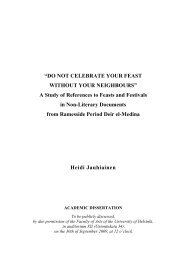BIA
bia51
bia51
You also want an ePaper? Increase the reach of your titles
YUMPU automatically turns print PDFs into web optimized ePapers that Google loves.
MAI 2015<br />
to return the mosque to its original state as<br />
part of the larger al-Darb al-Ahmar Programme.<br />
Minister of Antiquities Mamdûh al-Damâtî<br />
said the restoration work cost LE20 million and<br />
included the removal of scaffolding installed<br />
following the 1992 earthquake and installation<br />
of seismic retrofit measures, particularly in the<br />
minaret base, that will reinforce the durability<br />
of the building in the event of a future<br />
earthquake. Other restoration work included<br />
conservation of the delicate marble panels,<br />
Iznik ceramic tiles, roofing and façade.<br />
In restoring the mosque, the AKTC adopted<br />
a strategy that seeks to leverage culture to<br />
alleviate poverty, ‘Abd al-‘Azîz said. As in many<br />
of the locations in which it works, the Trust<br />
sought to create a series of activities that not<br />
only focus on the restoration of monuments,<br />
but also include the creation of public spaces,<br />
water and sanitation improvements, education<br />
and health initiatives, and microfinance.<br />
The World Monuments Fund and the Selz<br />
Foundation were also key supporters of the<br />
mosque’s restoration.<br />
At the opening ceremony, Karim Aga Khan<br />
described the event as “an immense pleasure<br />
and an extraordinary moment.” He said that<br />
the inauguration of the Aqsunqur Mosque<br />
marked the culmination of a larger revitalisation<br />
that has taken place over many years in<br />
historic Cairo.<br />
“As Muslims, we are invited to protect and<br />
enhance the world in which we live during our<br />
lifetimes. We are trustees of God’s creation,<br />
hence the word ‘trust’ in the name of the<br />
agency responsible for this restoration,” he<br />
said.<br />
The AKTC is involved in several restoration<br />
projects in the al-Darb al-Ahmar area, including<br />
restoration of the Umm al-Sultân Sha‘bân<br />
Mosque, Khâyyir Bek Complex, Palace of Emir<br />
Alen Aq al-Husâmî, Qubbat Tarâbây al-Sharîfî<br />
and al-Silihdâr Mosque.<br />
A few metres from the Bâb al-Wazîr<br />
Mosque, in the same district, stands the<br />
mosque of Emir Sayf al-Dîn Aymitsh al-Bagâsî,<br />
who was close to the Mameluke Sultan Barqûq<br />
and became a regent for his son Farag al-<br />
Bagâsî later fled Cairo when Farag came to<br />
power.<br />
The inner corridor of Aymitsh al-Bagâsî Mosque<br />
The entrance of his mosque is decorated<br />
with beautifully shaped leaf patterns and a<br />
ribbed dome. The main façade has a high-level<br />
inscription, plus two further inscription bands<br />
on the main portal, which has a muqarnas<br />
hood and a decoration of inverse heart-shaped<br />
leaf patterns. “It illustrates the characteristics of<br />
the 13 th -century decorative style,” ‘Abd al-‘Azîz<br />
said.<br />
On the northern side of the façade is a<br />
sabîl kuttâb (water fountain and library) that<br />
has a cup blazon and inscription on its<br />
wooden lintel. Mameluke historian al-Maqrîzî<br />
mentions the mosque in his account of these<br />
years, writing that al-Bagâsî built a mosque to<br />
be a school for teaching Hanafî jurisprudence.<br />
He had also built a hotel to accommodate<br />
foreign traders, a water basin for animals, and<br />
a domed mausoleum, al-Maqrîzî said.<br />
‘Abd al-‘Azîz said the mosque’s mausoleum<br />
was empty because al-Bagâsî was killed in<br />
Damascus in 1400. The mausoleum has a<br />
distinctive brick and plaster dome, which<br />
illustrates a popular 13 th -century design.<br />
It has ribs that rise straight up for the first<br />
quarter of the dome, then bend to the right<br />
and spiral up to the top. There is an<br />
inscription at its base and alternating keelarched<br />
windows and niches on the drum. The<br />
Comité de Conservation des Monuments de<br />
l’Art arabe restored the stonework on the<br />
mosque’s main facade.<br />
“The opening of these mosques highlights<br />
the ministry’s efforts to preserve and protect<br />
the country’s Islamic heritage, as well as to<br />
provide new tourist attractions,” al-Damâtî told<br />
the Weekly.<br />
<strong>BIA</strong> LI — Janvier/Juin 2015 141



